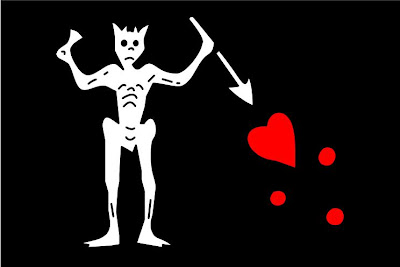 In 2007, the beaches of Ocracoke were voted #1 in the USA by Dr. Beach. The reason is obvious .... nearly 20 miles of nearly deserted wide, white sand beaches, warm shallow waters in tropical hues of blues, greens & purples, shells littering the shore.
In 2007, the beaches of Ocracoke were voted #1 in the USA by Dr. Beach. The reason is obvious .... nearly 20 miles of nearly deserted wide, white sand beaches, warm shallow waters in tropical hues of blues, greens & purples, shells littering the shore.

Blackbeard's Flag

The most notorious was a Captain Drummond, who used the name Edward Teach or Thatch, but those aware of his past knew him as the infamous pirate Blackbeard. Blackbeard roamed from the Caribbean to the Virginia Capes robbing ships. In November 1718, Blackbeard was finally captured near Ocracoke by Lt. Robert Maynard of the British Navy. Teach was reportedly shot five times and stabbed more than twenty times before he died and was decapitated. Legends about his death immediately sprang up, including the oft-repeated claim that Teach's headless body, after being thrown overboard, swam between 2 and 7 times around the Adventure before sinking. Much like today's visitors to Ocracoke, Blackbeard also enjoyed just hanging around. teeheehee
Ocracoke was finally realized as a town in 1753, when 20 to 30 families resided there. The area's earliest families included the Williams, Braggs, Gaskins, Wades, Styerins (Styron), Wahabs, and Howards.

The first lighthouse was built in 1798 on Shell Castle rock, abreast of the inlet. It was destroyed by lightning in 1818. The present lighthouse, one of the oldest still in use on the Atlantic Coast, was built in 1823. by Noah Porter for $11,359.35. At seventy-five feet, it is the shortest lighthouse on the North Carolina coast and can only be seen for 14 miles.
To be continued .......





2 comments:
That is some impressive photography, and a surprisingly detailed basic history of Ocracoke. I am wondering where your information comes from. I have collected and posted a great deal of Ocracoke Island history (see my Ocracoke Newsletters at http://www.villagecraftsmen.com -- just click on the link at the top of the page). I am especially curious about the names Bonner and Hall, which you say are early island family names. I would appreciate knowing where this information came from. Perhaps you could email me (you can find my email address through the village craftsmen web site. Thanks!
One more thing, http://www.ocracokevillage.com is the official Ocracoke Island web site.
Hi Philip - I've edited the post, removing the names Bonner and Hall since I can't locate the source again. L
Post a Comment